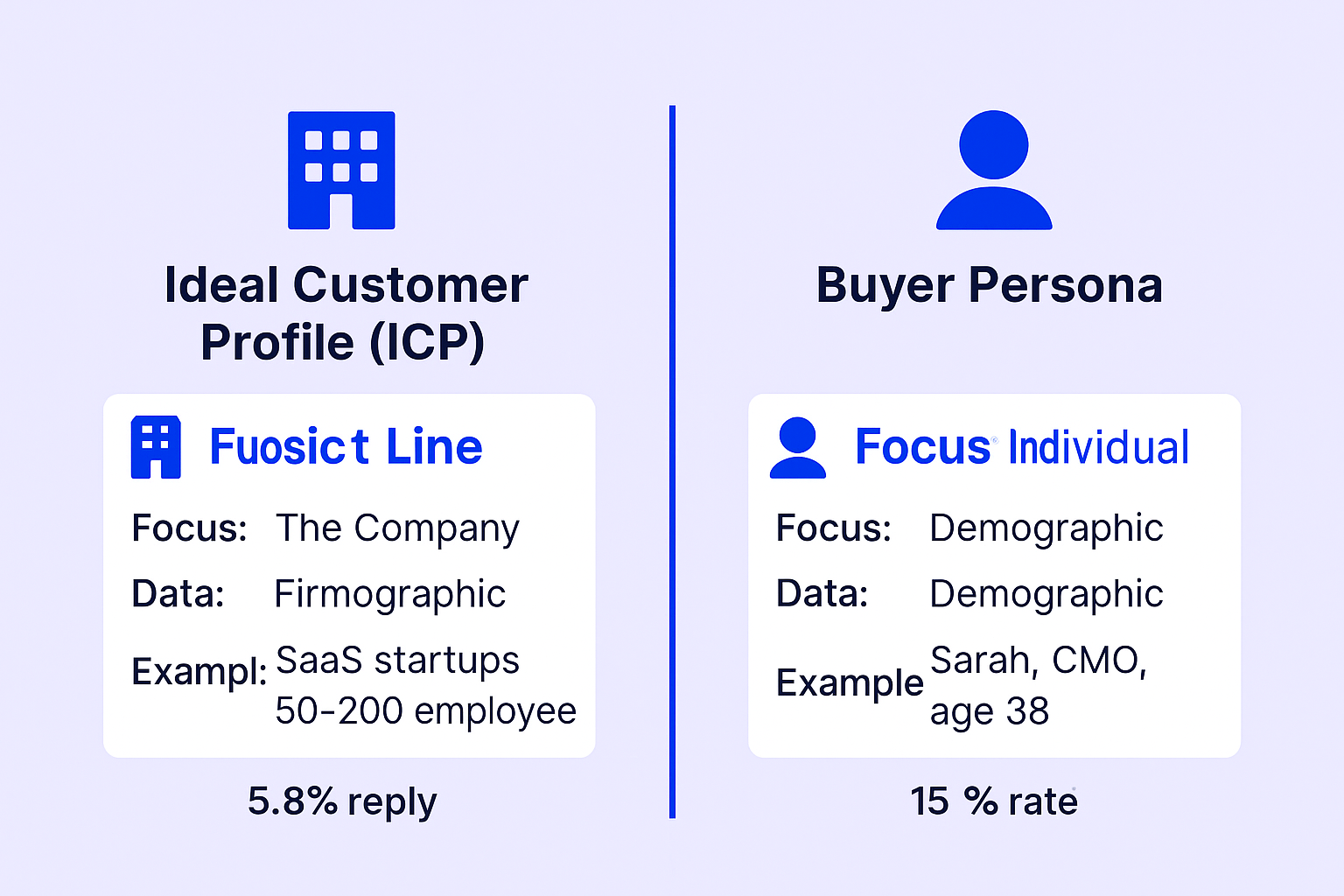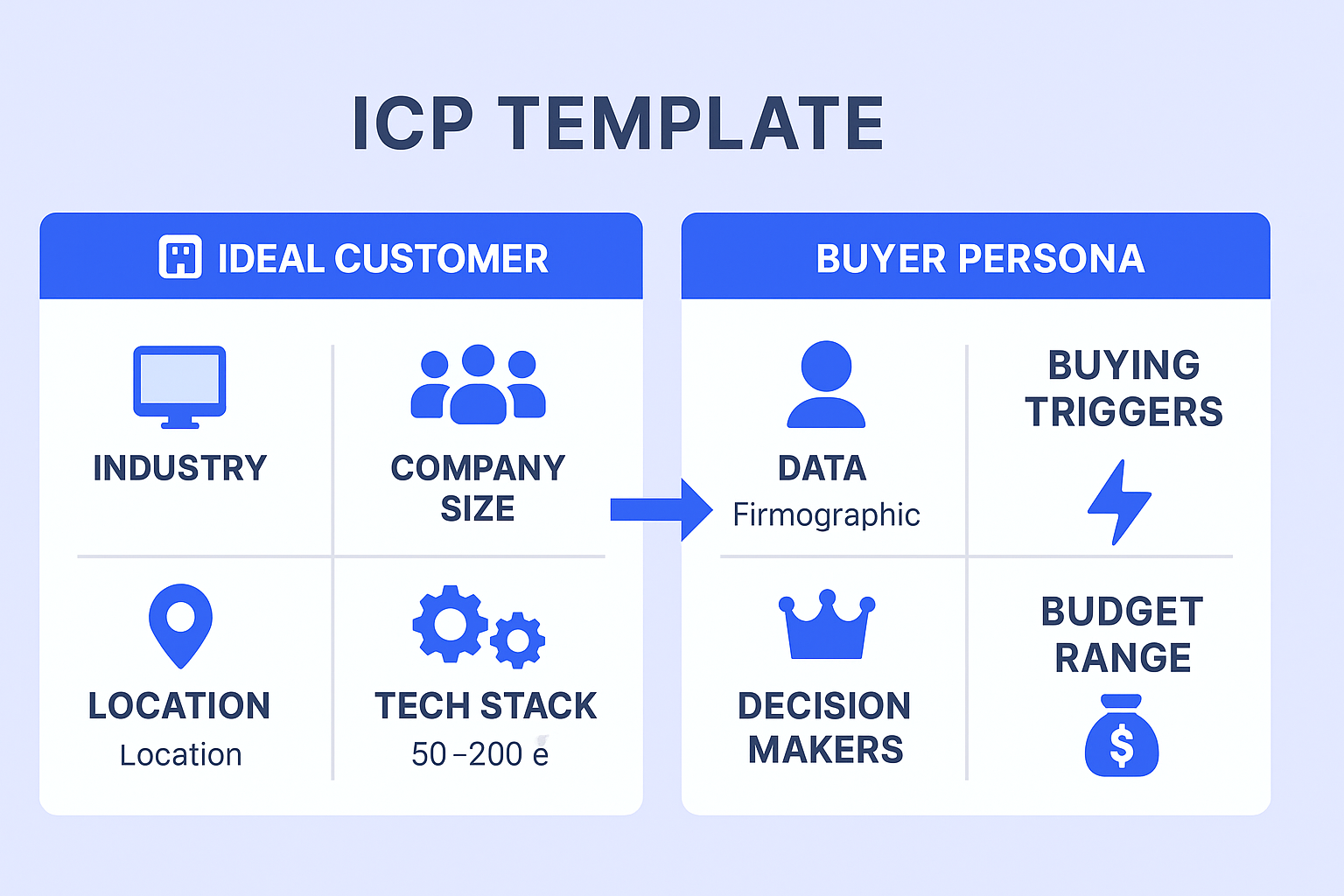- blog
- Lead Generation
- ICP Template: The Ultimate Guide to Building a High-Converting Ideal Customer Profile

ICP Template: The Ultimate Guide to Building a High-Converting Ideal Customer Profile
Table of Contents
In the world of B2B sales, targeting the right companies is not just helpful — it’s critical. Businesses that chase the wrong leads end up with long sales cycles, high churn, and wasted marketing budgets. That’s why every successful B2B business uses an Ideal Customer Profile (ICP).
An ICP template is your North Star. It tells you which companies are most likely to buy, succeed with your product, and stick with you long-term. It helps sales and marketing teams focus only on high-value opportunities.
In this guide, we’ll break down what an ICP is, why it matters, and exactly how to build one — step by step — with real business impact.
1. What is an Ideal Customer Profile (ICP)?
An Ideal Customer Profile (ICP) is a detailed representation of the type of company that would get the most value from your product or service — and provide the most value to your business in return.
It is NOT just a guess or a list of broad segments. It is a strategic, data-backed profile of a company that matches your product’s capabilities, your revenue model, and your growth goals.
Key ICP Characteristics Include:
- Industry – What sectors do your best customers belong to? (e.g., SaaS, Manufacturing, Healthcare)
- Company size – Measured in number of employees or revenue
- Geographic location – Domestic? Global? Regional?
- Pain points – What specific business problems do they face?
- Tech stack – What tools or systems do they already use?
- Decision-making process – Who makes the purchase decision?
- Buying triggers – Events or conditions that make them ready to buy (e.g., funding rounds, product launch)
Think of the ICP as a composite sketch of your “perfect company” customer — one that is likely to close quickly, use your solution fully, and become a long-term client.
2. Why Do You Need an Ideal Customer Profile Template?
Creating an ICP without a clear template is like baking without a recipe. You might get lucky, but more often, you’ll end up with a mess.
Here’s why every B2B sales and marketing team needs a structured ICP template:
2.1 High-Quality Target List
When your ICP is clearly defined, your sales team no longer wastes time chasing low-quality leads. Instead, they build a target account list based on companies that match your ICP criteria.
Example:
Imagine your SaaS product is designed for mid-sized marketing teams. With an ICP, you’d target:
- Marketing agencies with 50–200 employees
- Located in North America
- Using tools like HubSpot and Google Ads
- Spending $10K+/month on ad campaigns
By building a list with these parameters, you avoid chasing:
- Companies too small to afford you
- Enterprises that need more features than you offer
- Firms in unrelated industries
This means fewer calls, shorter sales cycles, and more conversions.
2.2 Qualified Lead Creation
Marketing becomes more efficient when it’s tailored to the right audience. Your ads, blogs, landing pages, and webinars should speak directly to companies that match your ICP.
An ICP helps you:
- Attract companies who are already facing the problems your product solves
- Increase form fill rates on lead magnets
- Get sales-qualified leads (SQLs) instead of just raw contacts
With an ICP, your team stops talking to leads who will never convert and starts talking to the ones that actually need your solution.
2.3 Account-Based Marketing (ABM) Campaign Design
ABM is a powerful B2B strategy where you personalize marketing campaigns to individual accounts. But to do ABM right, you need to know which accounts to personalize for — and that’s exactly what your ICP tells you.
Here’s how an ICP supports ABM:
- Identifies which accounts are worth pursuing
- Helps you craft hyper-specific messaging
- Allows you to align sales and marketing around shared goals
Without an ICP, your ABM campaigns may be beautifully crafted — but targeted at the wrong people.
2.4 Value-Driven Content Creation for B2B Sales Funnel
Content that works is content that resonates. When your ICP is clear, every blog, case study, or video becomes laser-focused on your audience’s specific needs and goals.
Example:
If your ICP includes HR tech startups with 50–100 employees, your content can focus on:
- Automating employee onboarding
- Managing hybrid workforce policies
- Tools to reduce HR costs in startups
That’s much more effective than generic content like “Why HR matters.”
ICP-based content = higher engagement, more trust, and better conversions.
2.5 Creating Brand Identity and Spreading Brand Awareness
When all your marketing messages speak directly to your ideal customer, you create a strong brand identity that feels relevant and trustworthy.
Here’s how an ICP helps:
- You speak your customer’s language
- You address real pain points
- You position your brand as the go-to solution
Over time, your ICP audience begins to recognize and trust your brand — even before they enter your funnel.
2.6 Get a Competitive Edge
In crowded markets, companies that understand their buyers better and earlier win. An ICP gives you the edge by:
- Helping you reach the right people before your competitors
- Improving your conversion rate
- Reducing customer acquisition costs
- Increasing lifetime value

Your competitors are spending the same budget — but you’re spending it smarter.
3. Is Ideal Customer Profile Similar to Buyer Persona?
This is a common area of confusion — let’s clear it up.
Feature
Ideal Customer Profile (ICP)
Buyer Persona
Focus
The company as a whole
The individual buyer or decision-maker
Use Case
Used to build target account lists, ABM campaigns
Used to tailor messaging to buyers
Data Type
Firmographic, technographic
Demographic, psychographic
Examples
SaaS startups with 50–200 employees
Sarah, CMO of a SaaS company, age 38, pain point: team scaling

In B2B, both are needed:
- Use the ICP to identify which companies to target
- Use the persona to understand how to sell to the people inside those companies
4. 6 Steps to Create an Ideal Customer Profile Template
Now, let’s walk through the exact process of creating an ICP that drives growth.
4.1 Identify the Problems Your Product Solves
Start with clarity: what specific, real-world problems does your product solve?
Examples:
- A CRM solves disorganized lead tracking
- An email marketing tool solves poor campaign automation
- A cybersecurity tool solves data vulnerability risks
Write these down. Be specific. Think in your customer’s voice: “I need to track leads better” or “We keep missing follow-ups.”
This helps you later identify which companies actually need your solution — and will gladly pay for it.
4.2 Understand the Common Traits of the Best Users of Your Product
Your current best customers are your greatest asset.
Look at:
- Who has the highest lifetime value (LTV)?
- Who is easy to onboard and retain?
- Who gives you referrals or case studies?
- Who expands quickly (upsells, renewals)?
Then analyze what they have in common:
- Are they in the same industry?
- Do they use the same tools?
- Did they all find you through the same channel?
This pattern recognition helps you define what a “high-fit company” looks like.
4.3 Gather Feedback Data
Go beyond assumptions. Collect real data from:
- CRM systems (closed-won vs closed-lost deals)
- Sales team notes (who’s easiest to sell to?)
- Customer support logs (who needs less hand-holding?)
- NPS or CSAT surveys (who loves your product?)
Conduct interviews with loyal customers. Ask:
- “What problem did our product solve for you?”
- “Why did you choose us over others?”
- “What would make you leave?”
This gives you real insights into why people buy and stick — which you can use to refine your ICP.
4.4 Analyze Gathered Data
Now combine all your findings to create a pattern.
Use filters like:
- Industry
- Team size
- Revenue bracket
- Use case
- Sales cycle length
- Preferred channels
- Budget range
Remove outliers. Just because one large enterprise used your product doesn’t mean all enterprises are a fit.
Focus on your sweet spot: customers that convert easily, use the product fully, and renew reliably.
4.5 Create an Ideal Customer Profile (ICP) Template
Here’s a comprehensive ICP Template you can adapt:
ICP Template (Editable Version)
|
Category |
Description |
|
Industry |
E.g., SaaS, EdTech, LegalTech |
|
Company Size |
50–200 employees |
|
Annual Revenue |
$2M–$50M |
|
Location |
US, Canada, UK |
|
Tech Stack |
CRM (HubSpot), Marketing Automation (Marketo), Cloud-based tools |
|
Pain Points |
Disorganized customer data, low engagement |
|
Buying Triggers |
Series A funding, new VP hired, product expansion |
|
Decision Makers |
Head of Marketing, RevOps Manager, CTO |
|
Budget Range |
$10,000–$50,000 per year |
|
Sales Cycle |
1–3 months |
|
Preferred Channels |
LinkedIn, Email Outreach, Webinars |
|
Customer Success Metrics |
30% increase in leads, 15% increase in ROI |

Customize this for your business. Keep refining it as your customer base grows and evolves.
5. How to Connect With Your Ideal Customer?
Knowing your ICP is one thing—connecting with them is another. Here’s how to establish meaningful, profitable relationships:
- Personalize your outreach: Refer to industry-specific challenges or use cases in your emails and demos.
- Create value-driven content: Publish blogs, case studies, and resources that speak directly to their problems.
- Engage on relevant platforms: Show up where your ICP spends time—LinkedIn, Slack communities, industry webinars.
- Offer solutions, not features: Don’t pitch a product. Offer solutions that address specific pain points.
- Nurture with relevance: Send drip emails, retargeting ads, and support touchpoints based on where they are in the buyer’s journey.
6. FAQs
1. What should an ideal customer profile template have?
2. What is the benefit of using an ideal customer profile template?
3. How can I use an ideal customer profile template to create a list?
4. What are the types of customer profiles?
5. Is customer profiling necessary for B2B marketing?

Find Companies Matching Your ICP
Stop chasing wrong leads. Get verified contacts from companies matching your ideal profile
